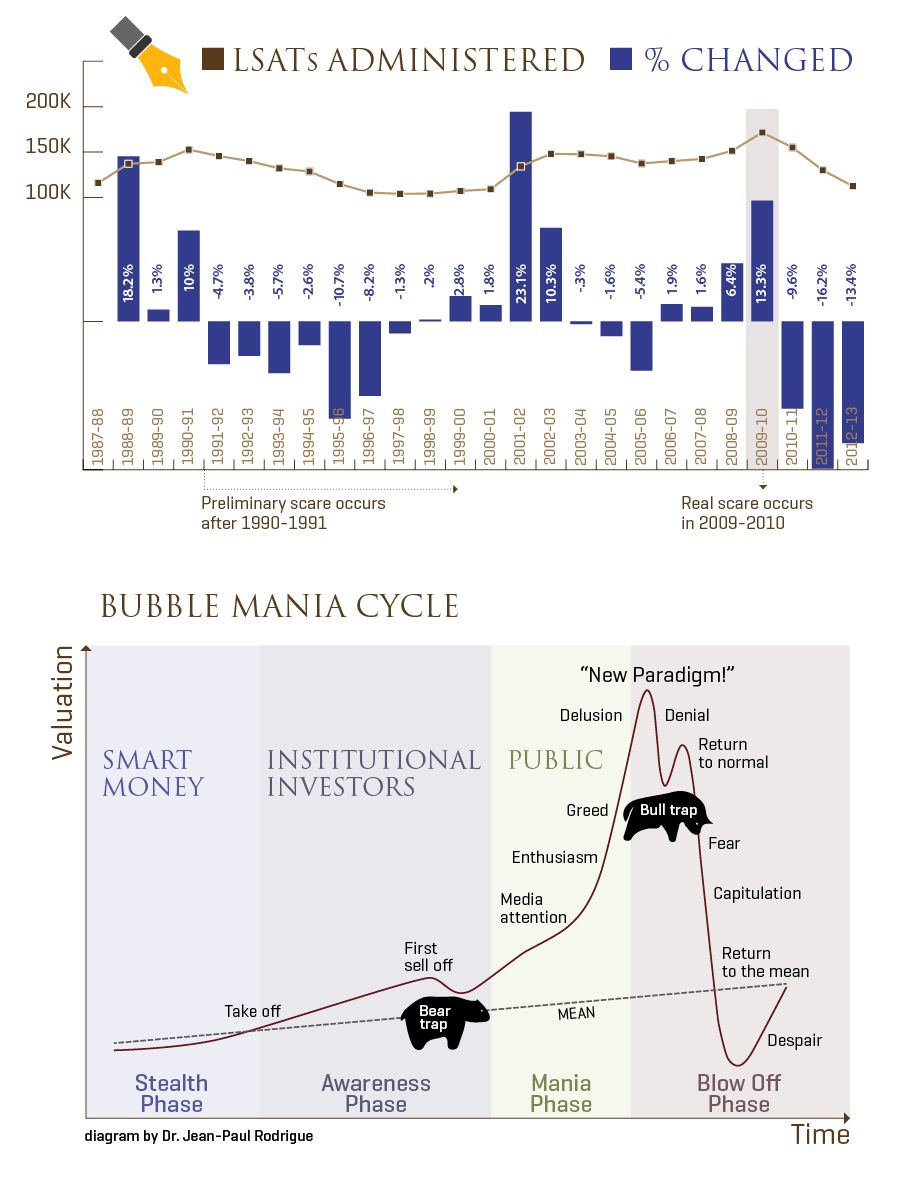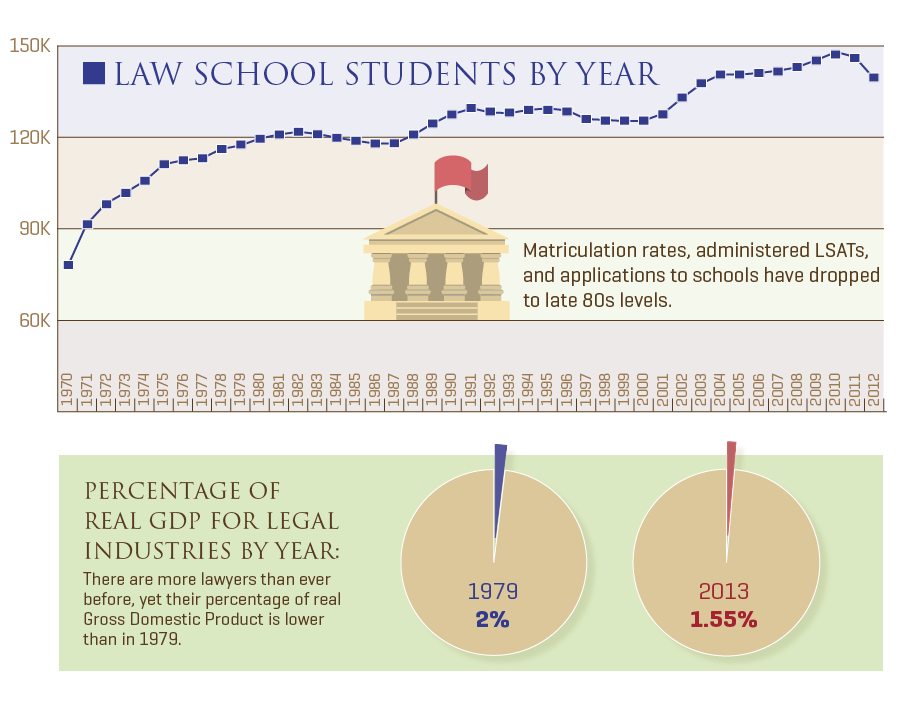Skeptics have warned that the US is “overlawyered” for years. The growth in interest surrounding legal education, and the opening of new law schools, however, didn’t betray such a problem. With close to half of law school grads having trouble finding legal work, and traditional entry level jobs not proving to be as lucrative as in the past, widespread acceptance of a law school bubble was born.
2010-2013 showed the largest decline in LSATs administered since the creation of the test, yet it will be a few years before the ranks of law school students are back to a more manageable number. Now that the law school bubble has ended, questions on legal education’s role in an increasingly digitized and global economy abound. Let’s take a look at the past, present, and future of the law school bubble.
[Tweet “Skeptics have warned that the US is “overlawyered” for years.”]
The Bubble and Mania Cycle
One would hope the schooling of our future lawyers wouldn’t be a purely economic matter. But it’s hard to miss the correlations between historic boom and bust cycles and trends in the legal education system. For the sake of clarity, let’s take a look at exactly what a bubble (and the corresponding crash) involves.
A bubble occurs when demand for a stock of good increases disproportionately with its inherent worth, or market performance. There have been countless bubbles in the history of the west (from the Dutch Tulip Mania, to the Dotcom crash of the early 2000’s). True bubbles are followed by crashes, in which the market adjusts with a significant drop in the value of a stock or good. This is the part where people lose money, time, and generally feel duped by something that seemed great not so long ago.

Most of the history of legal education has been a tale of “I want to grow up to be a doctor or lawyer.” This was the awareness stage. It was publicly known that having a legal education was both a mark of esteem–increasing your social capital–and a steady (and in most cases “good”) paycheck. As the ability of Americans to send their children to college and then professional schools steadily increased throughout the 20th century, so too did the number of law schools, and the number of lawyers. Until the early 90’s.
In economic terms, the first “sell off” of the law school bubble began in 1991. With good economic growth and other manias to take our attention (think, the tech boom), law school applications declined back to a steadier level of growth. These were the first years in which going into tech was a good alternative to the traditionally secure “doctor or lawyer” bit. The 90’s were also a time when strong economic growth offered jobs that only required undergraduate degrees that could rival the esteem and paycheck of the legal profession. It wasn’t until the Dotcom bubble burst in 2002 that the mania for law schools really began.
[Tweet “We finally fell out of our love affair with law.”]
2010 marked the establishment of a new paradigm in legal education. Of almost 50,000 legal graduates in 2010, only 51% of graduates found employment in private practice. Only 68% of grads found a position that required a law degree, and 32% of graduates didn’t manage get jobs in law at all. Coupled with an average law school loan debt of $98,500, we finally fell out of our love affair with law.
Adjustments Need to be Made
A glut of newly wealthy law schools, less-than-stellar job prospects, and ballooning student debt saw 2010-2013 exhibit the largest year-after year decrease in LSATs administered ever. Besides woes in the process of legal education, trends in the workplace also signaled a lessening need for tons of future lawyers. The emergence of platforms and apps automating simple procedures through the 2000’s, and the increased prevalence of outsourcing legal services to cheaper markets has undermined many of the tasks traditionally performed by your town square lawyer.

Between 1970 and 2011 new law school students have increased by over 60%, from less than 30,000 to over 50,000 in any given year. Meanwhile the percentage of real GDP made up of the legal industry has stagnated, actually falling from 2% of total GDP in 1970 to 1.55% in 2013. It should be noted that the massive growth of the economy as a whole does have the effect of downplaying the legal industry’s role as a portion of GDP. The fact that nearly every other expanding industry has need of legal services, however, counters this effect.
Besides the law school bubble graduating too many lawyers for the market to support, structural changes in the legal industry have also hastened the crash of the law school bubble. Traditionally, lawyers were the only source of legal knowledge, and by implicit agreement, lawyers rarely undercut other lawyers by altering service packages or the way legal goods were delivered. Through online services and outsourcing, lawyers have now been undercut, and forced to join in the larger legal services market. Today, 92% of lawyers believe greater price competition is a permanent change to the legal industry. While only 14% of lawyers believe the outsourcing of legal work is temporary.
[Tweet “Only 14% of lawyers believe the outsourcing of legal work is temporary.”]
Lingering Effects
For now, there are over 45,000 law graduates per year who compete for around 25,000 legal openings. Add to that unsuccessful job seekers from previous years, and for a majority of law school graduates, the task of finding a job is daunting. For law school graduates attending top schools the picture is slightly different, but not the assured path to success law school was once thought of.
Top law schools often cost upwards of $50,000 a year in tuition, and $10,000’s more in living costs. Sure, you’re more likely to get a job right out of a top school. But on average, your job may not make much more than what it cost to attend law school for a year.

The picture isn’t all bad. Our legal education system is just now adjusting from the law school bubble. The entering class of 2015 is set to be significantly smaller, and new opportunities in legal technology and overseas offer quite lucrative career options. For those lucky enough to fit the bill, high profile boutique firms are here to stay. While many simple procedures are automated or shipped overseas, highly complex and specialized legal matters still require local experts.
The key is not that law school is a bad choice, or not needed, but rather that those attending law school should be prepared for a vastly different world of legal affairs than they grew up hearing about. Within the decade, the vast and quickly emerging global middle class will have massive legal needs. Throughout the next 15 years, a growth in legal insurance, bought by someone who feels they might be at risk legally is predicted to grow. And lawyers are often one of the first additions to growing startups. In short, the key to succeeding in law in the 21st century is to be entrepreneurial and dynamic–something law school-aged students are known for today.
Related:
ULTIMATE GUIDE TO NATIONAL PARALEGAL ASSOCIATIONS
ULTIMATE GUIDE TO STATE PARALEGAL ASSOCIATIONS